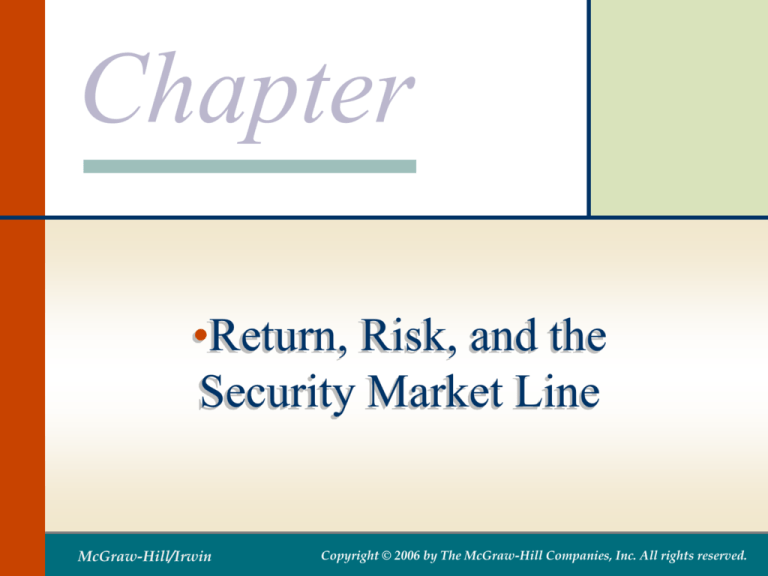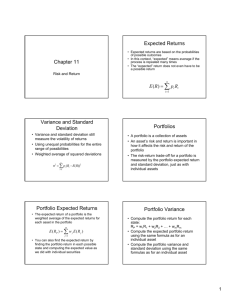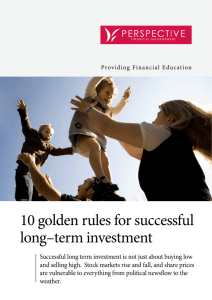
Chapter
•Return, Risk, and the
Security Market Line
McGraw-Hill/Irwin
Copyright © 2006 by The McGraw-Hill Companies, Inc. All rights reserved.
Key Concepts and Skills
•
•
•
•
•
•
Know how to calculate expected returns
Understand the impact of diversification
Understand the systematic risk principle
Understand the security market line
Understand the risk-return trade-off
Be able to use the Capital Asset Pricing
Model
13-1
Chapter Outline
•
•
•
•
•
•
Expected Returns and Variances
Portfolios
Risk: Systematic and Unsystematic
Diversification and Portfolio Risk
Systematic Risk and Beta
The Security Market Line
13-2
Expected Returns
• Expected returns are based on the
probabilities of possible outcomes
• The “expected” return does not even have
to be a possible return
n
E ( R) pi Ri
i 1
13-3
Example1: Expected Returns
• Suppose you have predicted the following
returns for stocks C and T in three possible
states of nature. What are the expected
returns?
• State
Probability
C
• Boom
0.3
15
• Normal
0.5
10
• Recession .2
2
• RC = .3(15) + .5(10) + .2(2) = 9.99%
• RT = .3(25) + .5(20) + .2(1) = 17.7%
T
25
20
1
13-4
Class Activity
Outcomes
Better
Possible Returns
32%
Probability
0.50
Same
17%
0.20
Worse
-10%
0.30
• Calculate Expected Returns
• If Risk Free Rate is 7% what will be Risk
Premium
13-5
Variance and Standard
Deviation
• Variance and standard deviation still
measure the volatility of returns
• Using unequal probabilities for the entire
range of possibilities
n
σ 2 pi ( Ri E ( R)) 2
i 1
13-6
Example: Variance and Standard
Deviation
• Consider the previous example 1. What are the
variance and standard deviation for each stock?
• Stock C
• 2 = .3(15-9.9)2 + .5(10-9.9)2 + .2(2-9.9)2 = 20.29
• = 4.5
• Stock T
• 2 = .3(25-17.7)2 + .5(20-17.7)2 + .2(1-17.7)2 =
74.41
• = 8.63
13-7
Class Activity
• Consider the following information:
•
•
•
•
•
State
Boom
Normal
Slowdown
Recession
Probability ABC, Inc. (%)
.25
15
.50
8
.15
4
.10
-3
• What is the expected return?
• What is the variance?
• What is the standard deviation?
13-8
Portfolios
• A portfolio is a collection of assets
• An asset’s risk and return are important in
how they affect the risk and return of the
portfolio
• The risk-return for a portfolio is measured
by the portfolio expected return and
standard deviation, just as with individual
assets
13-9
Example: Portfolio Weights
• Suppose you have $15,000 to invest and
you have purchased securities in the
following amounts. What are your portfolio
weights in each security?
•
•
•
•
$2000 of DCLK
$3000 of KO
$4000 of INTC
$6000 of KEI
•DCLK: 2/15 = .133
•KO: 3/15 = .2
•INTC: 4/15 = .267
•KEI: 6/15 = .4
13-10
Portfolio Expected Returns
• The expected return of a portfolio is the weighted
average of the expected returns for each asset in
the portfolio
m
E ( RP ) w j E ( R j )
j 1
• You can also find the expected return by finding
the portfolio return in each possible state and
computing the expected value as we did with
individual securities
13-11
Example: Expected Portfolio
Returns
• Consider the portfolio weights computed
previously. If the individual stocks have the
following expected returns, what is the expected
return for the portfolio?
•
•
•
•
DCLK: 19.69%
KO: 5.25%
INTC: 16.65%
KEI: 18.24%
• E(RP) = .133(19.69) + .2(5.25) + .267(16.65)
+ .4(18.24) = 13.75%
13-12
Portfolio Variance
• Compute the portfolio return for each state:
RP = w1R1 + w2R2 + … + wmRm
• Compute the expected portfolio return
using the same formula as for an individual
asset
• Compute the portfolio variance and
standard deviation using the same
formulas as for an individual asset
13-13
Example: Portfolio Variance
• Consider the following information
• Invest 50% of your money in Asset A and 50%
in B
Portfolio
• State Probability A
B
12.5%
• Boom .4
30%
-5%
• Bust .6
-10%
25% 7.5%
• What are the expected return and standard
deviation for each asset?
• What are the expected return and standard
deviation for the portfolio?
13-14
Systematic Risk
• Risk factors that affect a large number of
assets
• Also known as non-diversifiable risk or
market risk
• Includes such things as changes in GDP,
inflation, interest rates, etc.
13-15
Unsystematic Risk
• Risk factors that affect a limited number of
assets
• Also known as unique risk and assetspecific risk
• Includes such things as labor strikes, part
shortages, etc.
13-16
Returns
• Total Return = expected return +
unexpected return
• Unexpected return = systematic portion +
unsystematic portion
• Therefore, total return can be expressed as
follows:
• Total Return = expected return +
systematic portion + unsystematic portion
13-17
Diversification
• Portfolio diversification is the investment in
several different asset classes or sectors
• Diversification is not just holding a lot of
assets
• For example, if you own 50 internet stocks,
you are not diversified
• However, if you own 50 stocks that span
20 different industries, then you are
diversified
13-18
The Principle of Diversification
• Diversification can substantially reduce the
variability of returns without an equivalent
reduction in expected returns
• This reduction in risk arises because worse
than expected returns from one asset are
offset by better than expected returns from
another
• However, there is a minimum level of risk
that cannot be diversified away and that is
the systematic portion
13-19
Diversifiable Risk
• The risk that can be eliminated by
combining assets into a portfolio
• Often considered the same as
unsystematic, unique or asset-specific risk
• If we hold only one asset, or assets in the
same industry, then we are exposing
ourselves to risk that we could diversify
away
13-20
Total Risk
• Total risk = systematic risk + unsystematic
risk
• The standard deviation of returns is a
measure of total risk
13-21
Systematic Risk Principle
• There is a reward for bearing risk
• There is not a reward for bearing risk
unnecessarily
• The expected return on a risky asset
depends only on that asset’s systematic
risk since unsystematic risk can be
diversified away
13-22
Measuring Systematic Risk
• How do we measure systematic risk?
• We use the beta coefficient to measure
systematic risk
• What does beta tell us?
• A beta of 1 implies the asset has the same
systematic risk as the overall market
• A beta < 1 implies the asset has less
systematic risk than the overall market
• A beta > 1 implies the asset has more
systematic risk than the overall market
13-23
Total versus Systematic Risk
• Consider the following information:
• Security C
• Security K
Standard Deviation
20%
30%
Beta
1.25
0.95
• Which security has more total risk?
• Which security has more systematic risk?
• Which security should have the higher
expected return?
13-24
Example: Portfolio Betas
• Consider the previous example with the following
four securities
•
•
•
•
•
Security
DCLK
KO
INTC
KEI
Weight
.133
.2
.167
.4
Beta
2.685
0.195
2.161
2.434
• What is the portfolio beta?
• .133(2.685) + .2(.195) + .167(2.161) + .4(2.434)
= 1.731
13-25
Beta and the Risk Premium
• Remember that the risk premium =
expected return – risk-free rate
• The higher the beta, the greater the risk
premium should be
13-26
Security Market Line
• The security market line (SML) is the
representation of market equilibrium
• The slope of the SML is the reward-to-risk
ratio: (E(RM) – Rf) / M
• But since the beta for the market is
ALWAYS equal to one, the slope can be
rewritten
• Slope = E(RM) – Rf = market risk premium
13-27
The Capital Asset Pricing Model
(CAPM)
• The capital asset pricing model defines the
relationship between risk and return
• E(RA) = Rf + A(E(RM) – Rf)
• If we know an asset’s systematic risk, we
can use the CAPM to determine its
expected return
13-28
Class Activity
• What will be the expected rate of
return on AAPL stock with a beta of
1.49 if the risk-free rate of interest is
2% and if the market risk premium,
which is the difference between
expected return on the market
portfolio and the risk-free rate of
return is estimated to be 8%?
13-29
Factors Affecting Expected
Return
• Pure time value of money – measured by
the risk-free rate
• Reward for bearing systematic risk –
measured by the market risk premium
• Amount of systematic risk – measured by
beta
13-30
Quick Quiz
• How do you compute the expected return and
standard deviation for an individual asset? For a
portfolio?
• What is the difference between systematic and
unsystematic risk?
• What type of risk is relevant for determining the
expected return?
• Consider an asset with a beta of 1.2, a risk-free
rate of 5% and a market return of 13%.
• What is the reward-to-risk ratio in equilibrium?
• What is the expected return on the asset?
13-31







